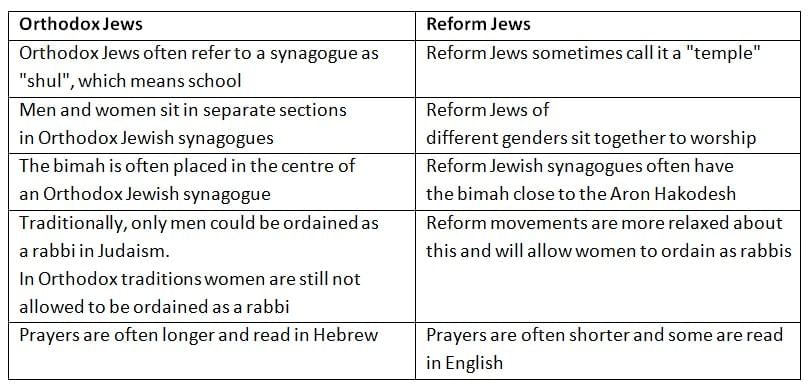Year 11 Exam > Year 11 Notes > Religion, Philosophy & Ethics for GCSE/IGCSE > Services at the Synagogue
Services at the Synagogue | Religion, Philosophy & Ethics for GCSE/IGCSE - Year 11 PDF Download
The Difference Between Services in Orthodox & Reform Synagogues
Services in the Synagogue
Synagogue services are vital for both Reform and Orthodox Jewish communities, fostering unity among members.
- A Rabbi typically leads worship services in both Orthodox and Reform synagogues.
- A cantor, known as the hazzan, often stands at the front, facing the Aron Hakodesh, to lead prayers, which may be spoken, sung, or chanted.
- The siddur, a prayer book, is used during services and includes the daily prayers.
- Services begin with opening prayers, followed by the recitation of the Shema.
- The Shema is the Jewish declaration of faith in one God:
"Hear O Israel! The Lord is our God, the Lord alone" (Deuteronomy 6:4).
- The Amidah, a central prayer in Jewish worship, is performed silently while worshippers stand facing Jerusalem.
- Worshippers reflect on the prayer’s words in their minds rather than speaking them aloud.
- The Amidah consists of a series of blessings:
- The first three blessings praise God and seek His mercy
- The middle thirteen blessings request God’s assistance.
- The final blessing expresses gratitude to God.
- Services include Torah readings and conclude with final prayers, such as the Aleinu, which praises God.
- Most synagogues hold daily prayers and celebrate festivals, but the primary communal gathering occurs during the Shabbat service.
The Difference Between Orthodox and Reform Synagogues
Orthodox and Reform synagogues have distinct differences in their practices and settings.

The document Services at the Synagogue | Religion, Philosophy & Ethics for GCSE/IGCSE - Year 11 is a part of the Year 11 Course Religion, Philosophy & Ethics for GCSE/IGCSE.
All you need of Year 11 at this link: Year 11
|
172 docs|3 tests
|
FAQs on Services at the Synagogue - Religion, Philosophy & Ethics for GCSE/IGCSE - Year 11
| 1. What are the main differences in worship styles between Orthodox and Reform synagogues? |  |
Ans. Orthodox synagogues typically follow traditional liturgy and prayers in Hebrew, maintaining a strict adherence to Jewish law (Halakha). The services are often longer and include rituals such as wearing a tallit (prayer shawl) and tefillin (phylacteries). In contrast, Reform synagogues may use a mix of Hebrew and the local language in their services, often incorporating contemporary music and shorter, more informal worship styles.
| 2. How does the role of the rabbi differ in Orthodox and Reform synagogues? |  |
Ans. In Orthodox synagogues, the rabbi serves primarily as a religious leader and teacher, guiding the community in strict adherence to Jewish law. The rabbi's authority is often rooted in traditional interpretations of scripture. In Reform synagogues, the rabbi may take on a more progressive role, emphasizing social justice, community engagement, and individual interpretation of Jewish teachings, often adapting traditions to be more inclusive.
| 3. What is the significance of gender roles in Orthodox versus Reform synagogue services? |  |
Ans. In Orthodox synagogues, gender roles are traditionally defined, with men and women often separated during services. Men lead prayers and read from the Torah, while women may have limited roles. Reform synagogues promote gender equality, allowing both men and women to participate equally in all aspects of the service, including leading prayers and reading from the Torah.
| 4. How do the two movements approach the observance of Jewish laws and customs? |  |
Ans. Orthodox Judaism strictly observes Jewish laws and customs as prescribed in the Torah and Talmud, maintaining traditional practices such as dietary laws (kashrut) and Sabbath observance. Reform Judaism, however, encourages individual interpretation and often relaxes traditional laws, allowing adherents to choose which customs to observe based on personal beliefs and values, focusing more on ethical principles than ritualistic requirements.
| 5. What are the community and social aspects of Orthodox and Reform synagogues? |  |
Ans. Orthodox synagogues tend to foster a tightly-knit community centered around traditional practices and shared beliefs, often engaging in communal activities that reinforce these values. Reform synagogues, while also community-oriented, emphasize inclusivity and social action, often encouraging members to engage in social justice initiatives and interfaith dialogue, reflecting a broader understanding of community beyond just religious observance.
Related Searches















